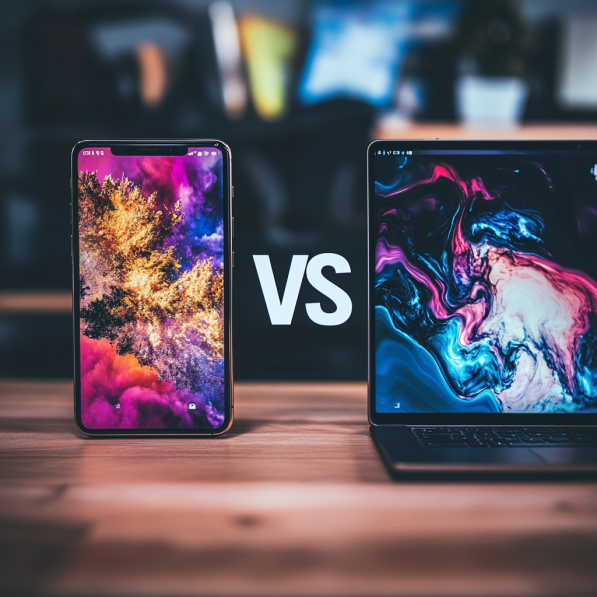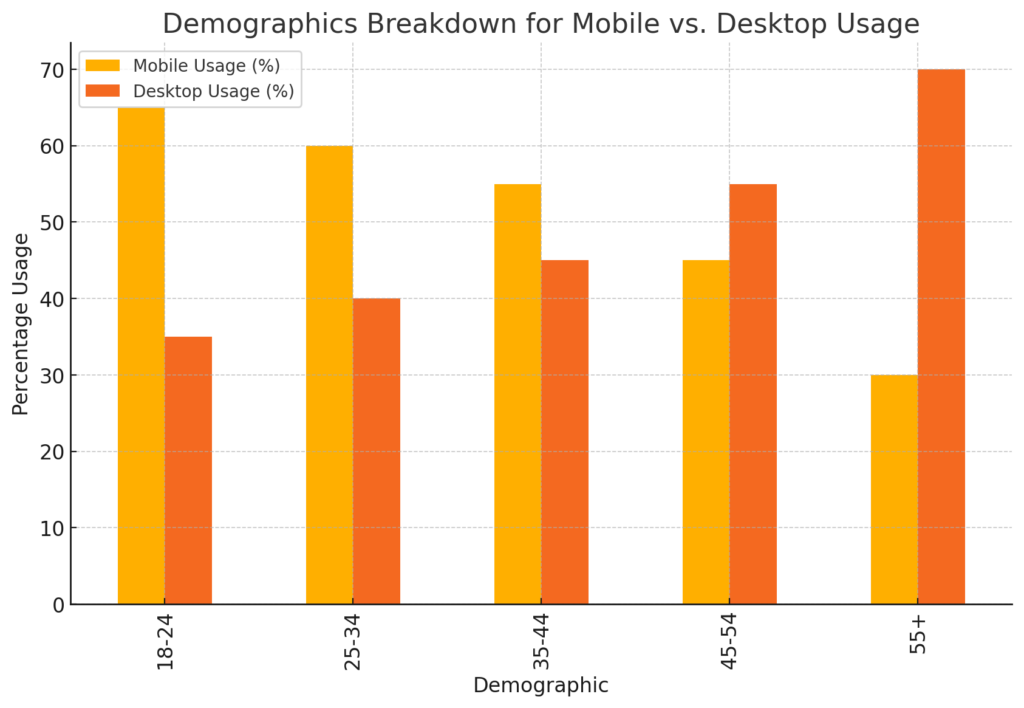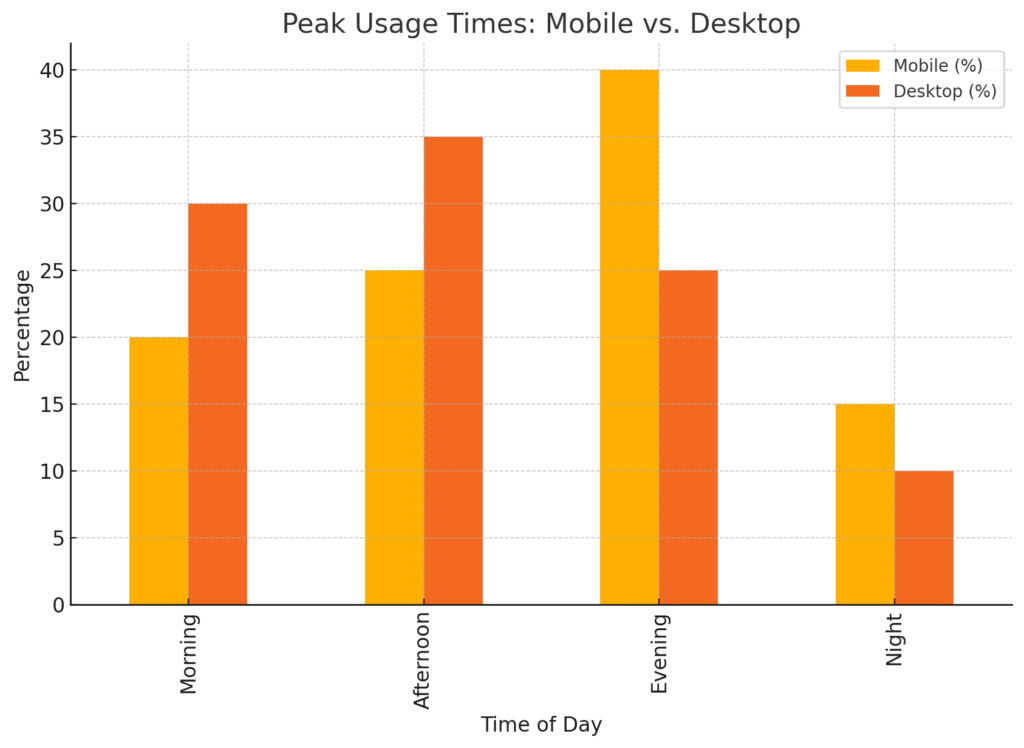Mobile vs Desktop Usage Trends

So looking at the digital landscape it would appear over recent years, are over the most recent decade to be more precise, there has been a significant shift from desktop ( otherwise known as PC laptop usage) gradually moving over to mobile usage.
This has mainly been down to the explosion of smartphones, and the relative ease of access for everyone globally.
Therefore, it is important for all website owners to recognise how the Landscape is changing when it comes to online presence, as webmasters, we can adapt and steer towards taking good advantage of this.
Historical Perspective
So, where did it all begin?
It was back in the late 1990s and early 2000s when desktop computers came inhello for you today in this guy loyalty team I connect with today as the dominant technology in use.
Midway in the 2000’s smartphones gradually got introduced, which LED on to the introduction of mobile apps and ultimately leading to mobile networks like 4G and 5G.
During this. There was a slow transition and handover from desktop to mobile internet usage.

Current Statistics
The latest data for 2024 shows that globally, mobile devices account for 58% of internet usage, while desktop usage stands at 42%.
Numbers like these underline the importance of now focusing and optimising for mobile users.
let’s break down by demographics, the usage patterns reveal interesting insights:
- For the 18-24 age group, mobile usage is at 65%, while desktop usage is at 35%.
- The 25-34 age group has 60% mobile usage compared to 40% desktop usage.
- Users aged 35-44 show a 55% preference for mobile and 45% for desktop.
- In the 45-54 age group, mobile usage drops to 45%, with desktop usage at 55%.
- For users aged 55 and above, mobile usage is at 30%, while desktop dominates at 70%.
The below chart displays the Global Mobile Vs Desktop Usage in 2024

Usage Patterns
Differences in browsing habits between mobile and desktop users:
| Habit | Mobile (%) | Desktop (%) |
|---|---|---|
| Short Sessions | 70 | 30 |
| Long Sessions | 20 | 50 |
| Multiple Sessions | 10 | 20 |
The below chart displays the Global Mobile Vs Desktop Demographic

Breakdown by demographics (age, gender, region):
| Demographic | Mobile Usage (%) | Desktop Usage (%) |
|---|---|---|
| 18-24 | 65 | 35 |
| 25-34 | 60 | 40 |
| 35-44 | 55 | 45 |
| 45-54 | 45 | 55 |
| 55+ | 30 | 70 |
Usage Patterns
The browsing habits between mobile and desktop users also vary significantly.
- Mobile users tend to have shorter sessions, with 70% of them preferring quick visits, compared to 30% of desktop users.
- Long sessions are more common among desktop users, accounting for 50%, while only 20% of mobile users engage in extended browsing.
- Multiple sessions throughout the day are preferred by 20% of desktop users and 10% of mobile users.
Peak usage times also differ between mobile and desktop devices.
- Mobile usage peaks in the evening at 40%, followed by the afternoon at 25%, morning at 20%, and night at 15%.
- Desktop usage, on the other hand, peaks in the afternoon at 35%, followed by the morning at 30%, evening at 25%, and night at 10%.
This pattern, shown in the bar chart, indicates the optimal times to target mobile and desktop users for maximum engagement.
The below chart displays the Mobile Vs Desktop peak usage times

Peak usage times for mobile vs. desktop:
| Time of Day | Mobile (%) | Desktop (%) |
|---|---|---|
| Morning | 20 | 30 |
| Afternoon | 25 | 35 |
| Evening | 40 | 25 |
| Night | 15 | 10 |
Advantages of Mobile Usage
Convenience and Accessibility
So one of the main reasons why mobile usage is now huge, is mainly down to its convenience. not only are the devices small and portable, but with networks readily available, users can be on them constantly, and often they are! 🙂
This accessibility drives higher engagement and frequent visits.
Advantages of Desktop Usage
Larger Screens and Better User Experience for Certain Tasks
Although, without a shadow of a doubt, mobile is winning this race, desktops, PCs, and laptops still have their place.
Desktops offer larger screens, making them ideal for tasks that require detailed viewing. This includes activities like graphic design, video editing, and extensive research.
Higher Engagement for Detailed Content Consumption
One key advantage a desktop use will have over mobile, is there more highly engaged sessions. due to the easier nature of technology usage, a bigger screen over a smaller screen, it is therefore more likely a person’s attention will be harnessed over a smaller screen.
Meaning, users are more likely to spend longer periods consuming detailed articles, reports, and multimedia content.
User Engagement and Behavior
Differences in Session Duration, Bounce Rates, and Conversion Rates
What you will find if you don’t already know, mobile users generally have shorter session durations compared to desktop users, and arguably a shorter attention span, as they tend to be flicking through rather than reading and paying attention.
Bounce rates tend to be higher on mobile due to smaller screens and less detailed viewing. Conversion rates are often higher on desktops, as users prefer completing transactions on larger screens.
Preferred Types of Content on Mobile vs. Desktop
So all the information above has led to this critical moment, what does this all mean, why do we need to know the habits and usage of mobile and desktop users?
In short, the answer, as a website owner, is purely to either take advantage of Movile and Desktop Usage, harness it, are make use of the way things are going for your future customers.
So for instance, mobile users favor quick, easily digestible content like social media updates, short articles, and videos.
Whereas, desktop users prefer more detailed and extensive content such as long-form articles, comprehensive reports, and high-quality videos.
This is very important information to be aware of as a webmaster, if you target your customers incorrectly, then worst case scenario you’re not going to get any sales or leads, so all this is worth knowing!

SEO Considerations
How Mobile Usage Affects Search Engine Optimization
Did you know, search engines prioritize mobile-friendly websites due to the rise in mobile usage?
Mobile-first indexing means search engines predominantly use the mobile version of a site for indexing and ranking. Which if you think about it does make sense!
See Our Recommendations for SEO Plugins Here
Tips for Optimizing for Mobile and Desktop
So, with the above in mind it is essential nowadays to make sure that your website is mobile responsive, across all devices from smartphones to tablets.
What is also equally essential, is the load time of your website, without a faster load time, because let’s face it the whole world is becoming more and more impatient, your rankings will suffer and so all your traffic.
When creating content keep it’s a clear and concise for mobile, but feel free to go more detailed targeting desktop users.
Also, use mobile-specific features like click-to-call buttons where applicable. okay
Future Trends
Predictions for the Future of Mobile and Desktop Usage
It’s pretty safe to say that the future is already here, mobile isn’t going anywhere, if anything it’s going to grow, the advancement of smartphone technology, and the increase of internet access is going to cement this.
Desktop and computer usage will still remain significantly high, as everyone still likes to use their PC from home, but the gap between mobile and desktop can only widen, that’s just my opinion but going off recent evidence that is the trend between desktop and mobiles right now, However you look at it both platforms are still important and have their place in our marketing efforts.







